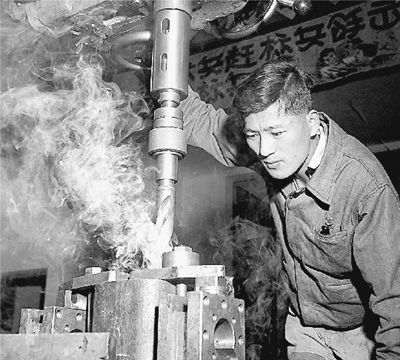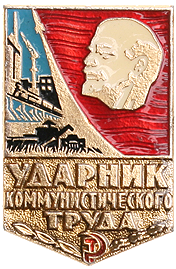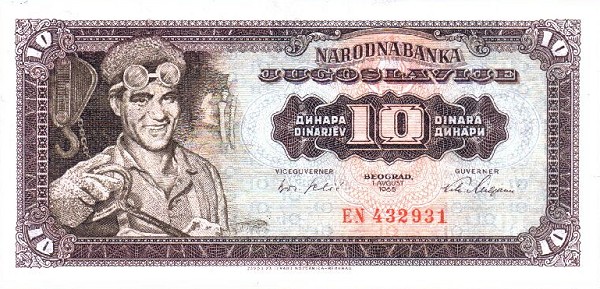|
Udarnik
An udarnik ( rus, уда́рник, p=ʊˈdarnʲɪk; English plural udarniks or udarniki), also known in English as a shock worker or strike worker (collectively known as shock brigades or a shock labour team) was a highly productive worker in the Soviet Union, the Eastern Bloc, and other communist countries. The term derived from the expression "udarny trud" for "superproductive, enthusiastic labour". In the Soviet Union, the term was linked to Shock worker of Communist Labour (''Ударник коммунистического труда''), a Soviet honorary title, as well as Alexey Stakhanov and the movement named after him. However, the terminology of shock workers has also been used in other socialist states, most notably in the People's Republic of China, North Korea, the People's Republic of Bulgaria, and the Socialist Federal Republic of Yugoslavia. Soviet shock workers were not always necessarily citizens of the USSR, as one British communist and trade union leader Je ... [...More Info...] [...Related Items...] OR: [Wikipedia] [Google] [Baidu] |
Model Worker
Model worker (, abbreviated as 劳模 or ''láomó'') refers to an exemplary worker who exhibits some or all of the traits appropriate to the ideal of the socialism. Exemplary worker come from various sectors of the Chinese economy, including the industry, agricultural, service and the cultural sectors to show the inclusiveness of the People's Republic of China. Echoing the gender equality advocate of the Chinese Communist Party (CCP), both men and women comprise the pool of model workers. Since the founding of the People's Republic in 1949, thousands of male and female model workers have been selected from a wide range of sectors. A few model workers also came from ethnic minority groups to show the ethnic unity policy of the CCP. Higher authorities take charge of the decision on selecting model worker based on their work performance, and political consciousness, patriotism, "worship of science," activities in environmental protection, and the pursuit of excellence. National model w ... [...More Info...] [...Related Items...] OR: [Wikipedia] [Google] [Baidu] |
Shock Worker Of Communist Labour
The Shock worker of Communist Labour ( rus, Ударник коммунистического труда, r=Udarnik kommunisticheskogo truda) was an official title of honour awarded in the Soviet Union to those who displayed exemplary performance in labour discipline (''udarniks''). It was awarded with a badge and certificate, as well as a cash prize. The title of shock worker ('udarnik') had existed at least since the 1930s. However, its promotion was developed in the 1950s as part of a competition in honour of the XXI Congress of the Communist Party of the Soviet Union, to encourage a communist attitude towards work and the creation of the material-technical basis for the development of communism and education towards a communist society. It was also awarded through the Young Communist League. According to ''Pravda'', "the main feature of the competition for the title of Shock worker of Communist Labour - as stated in the Salutation of the CPSU Union Conference by participants o ... [...More Info...] [...Related Items...] OR: [Wikipedia] [Google] [Baidu] |
Stakhanovite Movement
The term Stakhanovite () originated in the Soviet Union and referred to workers who modeled themselves after Alexey Stakhanov. These workers took pride in their ability to produce more than was required, by working harder and more efficiently, thus strengthening the socialist state. The Stakhanovite Movement was encouraged due to the idea of socialist emulation. It began in the coal industry but later spread to many other industries in the Soviet Union. The movement eventually encountered resistance as the increased productivity led to increased demands on workers. History The Stakhanovite movement began during the Soviet second 5-year plan in 1935 as a new stage of socialist competition, emerging as a continuation of the rapid industrialization and forced collectivization that had transpired seven years prior. The movement took its name from Aleksei Grigorievich Stakhanov, who reportedly mined 102 tons of coal in less than 6 hours (14 times his quota) on 31 August 1935. However ... [...More Info...] [...Related Items...] OR: [Wikipedia] [Google] [Baidu] |
Plakat Mayakowski Gross
The Siamese fighting fish (''Betta splendens''), commonly known as the betta, is a freshwater fish native to Southeast Asia, namely Cambodia, Laos, Myanmar, Malaysia, Indonesia, Thailand, and Vietnam. It is one of 73 species of the genus ''Betta,'' but the only one eponymously called "betta", owing to its global popularity as a pet; ''Betta splendens'' are among the most popular aquarium fish in the world, due to their diverse and colorful morphology and relatively low maintenance. Siamese fighting fish are endemic to the central plain of Thailand, where they were first domesticated at least 1,000 years ago, among the longest of any fish. They were initially bred for aggression and subject to gambling matches akin to cockfighting. Bettas became known outside Thailand through King Rama III (1788-1851), who is said to have given some to Theodore Cantor, a Danish physician, zoologist, and botanist. They first appeared in the West in the late 19th century, and within decades bec ... [...More Info...] [...Related Items...] OR: [Wikipedia] [Google] [Baidu] |
Soviet Phraseology
Soviet phraseology, or Sovietisms, i.e., the neologisms and cliches in Russian language of the epoch of the Soviet Union, has a number of distinct traits that reflect the Soviet way of life and Soviet culture and politics. Most of these distinctions are ultimately traced (directly or indirectly, as a cause-effect chain) to the utopic goal of creating a new society, the ways of the implementation of this goal and what was actually implemented. The topic of this article is not limited to the Russian language, since this phraseology permeated all national languages in the Soviet Union. Nevertheless, Russian was the language of inter-nationality communication in the Soviet Union, and was declared official language of the state in 1990, therefore it was the major source of Soviet phraseology. Taxonomy The following main types of Sovietism coinage may be recognized: *Semantic shift: for example, "to throw out" acquired the colloquial meaning of "to put goods for sale". In the circumst ... [...More Info...] [...Related Items...] OR: [Wikipedia] [Google] [Baidu] |
Pasha Angelina
Praskovya "Pasha" Nikitichna Angelina (russian: Праско́вья Ники́тична Анге́лина; – 21 January 1959) was a Soviet udarnik and Stakhanovite at the time of the first Five-Year-Plans. She was recognized as one of the first female tractor-operators in the USSR and was made a symbol of the technically educated female Soviet worker. Biography Angelina was born in Starobesheve, into a Greek family of peasants. Her father was a farmhand and her mother whitewashed huts. In 1929, she started attending tractor-driving courses in her native oblast while also working at a dairy farm. In 1933, she organized an all-female tractor team that was reported to have achieved 129% of the quota and thus to have ranked first among the tractor teams of the region. She was made a celebrity, placed prominently in the media and depicted on propaganda posters. In 1935, she was among the "Champions of Agricultural Labour" selected to hold a conference with the leaders of the ... [...More Info...] [...Related Items...] OR: [Wikipedia] [Google] [Baidu] |
Arif Heralić
Arif Heralić (5 May 1922 – 17 June 1971) was a Bosnian Roma metal worker on a blast furnace in Zenica. He had 11 children and issues with alcoholism and mental illness. As a disabled worker, Heralić died in extreme poverty in 1971. Banknote and iconography His picture was taken by Nikola Bibić, a '' Borba'' news photographer, in 1954 and from the papers he came to feature on a 1,000 Yugoslav dinar banknote issued from 1955 to 1981, re-nominated to ten new dinars since 1965. He is still (as of 2013) popular as an icon of industrial worker in the former Yugoslavia. The banknote is not to be confused with the 20,000 dinar banknote, which depicts Alija Sirotanović. See also *Alija Sirotanović Alija Sirotanović (14 August 1914 – 16 May 1990) was a Yugoslav miner, Hero of Socialist Labour and perhaps the most famous of all Yugoslav udarniks. He was held up by the Communist Party of Yugoslavia to be a model of a hard-worker in the ..., model for a 20,000 dinara bankn ... [...More Info...] [...Related Items...] OR: [Wikipedia] [Google] [Baidu] |
Alija Sirotanović
Alija Sirotanović (14 August 1914 – 16 May 1990) was a Yugoslav miner, Hero of Socialist Labour and perhaps the most famous of all Yugoslav udarniks. He was held up by the Communist Party of Yugoslavia to be a model of a hard-worker in the former Yugoslavia. Early life and family Alija Sirotanović, a Bosniak, was born in Orahovo, a village in central Bosnia near the town of Breza, and grew up in Trtorići, another nearby village. He was born in 1914, while Bosnia and Herzegovina was a part of Austria-Hungary. He had six brothers and two sisters, all of whom were miners. One of his brothers, Ahmed, died in a mining disaster in 1970. Mining record and fame Sirotanović worked in the coal mine in Breza. In 1947 Sirotanović set a record in coal extracting. On 24 July 1949, Sirotanović participated in an inter-mine competition at the mine at Kreka. He and his eight-man crew mined in an 8-hour shift 128 carloads of brown coal, that is, 152 tons of coal in a single shift, som ... [...More Info...] [...Related Items...] OR: [Wikipedia] [Google] [Baidu] |
Slovak Language
Slovak () , is a West Slavic language of the Czech–Slovak group, written in Latin script. It is part of the Indo-European language family, and is one of the Slavic languages, which are part of the larger Balto-Slavic branch. Spoken by approximately 5 million people as a native language, primarily ethnic Slovaks, it serves as the official language of Slovakia and one of the 24 official languages of the European Union. Slovak is closely related to Czech, to the point of mutual intelligibility to a very high degree, as well as Polish. Like other Slavic languages, Slovak is a fusional language with a complex system of morphology and relatively flexible word order. Its vocabulary has been extensively influenced by Latin and German and other Slavic languages. The Czech–Slovak group developed within West Slavic in the high medieval period, and the standardization of Czech and Slovak within the Czech–Slovak dialect continuum emerged in the early modern period. In the later mi ... [...More Info...] [...Related Items...] OR: [Wikipedia] [Google] [Baidu] |
Czech Language
Czech (; Czech ), historically also Bohemian (; ''lingua Bohemica'' in Latin), is a West Slavic language of the Czech–Slovak group, written in Latin script. Spoken by over 10 million people, it serves as the official language of the Czech Republic. Czech is closely related to Slovak, to the point of high mutual intelligibility, as well as to Polish to a lesser degree. Czech is a fusional language with a rich system of morphology and relatively flexible word order. Its vocabulary has been extensively influenced by Latin and German. The Czech–Slovak group developed within West Slavic in the high medieval period, and the standardization of Czech and Slovak within the Czech–Slovak dialect continuum emerged in the early modern period. In the later 18th to mid-19th century, the modern written standard became codified in the context of the Czech National Revival. The main non-standard variety, known as Common Czech, is based on the vernacular of Prague, but is now spoken as an ... [...More Info...] [...Related Items...] OR: [Wikipedia] [Google] [Baidu] |
Pronunciation
Pronunciation is the way in which a word or a language is spoken. This may refer to generally agreed-upon sequences of sounds used in speaking a given word or language in a specific dialect ("correct pronunciation") or simply the way a particular individual speaks a word or language. Contested or widely mispronounced words are typically verified by the sources from which they originate, such as names of cities and towns or the word GIF#Pronunciation of GIF, GIF. A word can be spoken in different ways by various individuals or groups, depending on many factors, such as: the duration of the cultural exposure of their childhood, the location of their current residence, speech disorder, speech or list of voice disorders, voice disorders, their ethnic group, their social class, or their education. Linguistic terminology Syllables are counted as units of sound (Phone (phonetics), phones) that they use in their language. The branch of linguistics which studies these units of sound is ... [...More Info...] [...Related Items...] OR: [Wikipedia] [Google] [Baidu] |
Czechoslovak Socialist Republic
The Czechoslovak Socialist Republic, ČSSR, formerly known from 1948 to 1960 as the Czechoslovak Republic or Fourth Czechoslovak Republic, was the official name of Czechoslovakia from 1960 to 29 March 1990, when it was renamed the Czechoslovak Federative Republic, sk, Česko-slovenská federatívna republika, ČSFR. On 23 April 1990, it became the Czech and Slovak Federative Republic, sk, Česká a Slovenská Federatívna Republika, ČSFR. From 1948 until the end of November 1989, the country was under Communist rule and was regarded as a satellite state in the Soviet sphere of interest. Following the coup d'état of February 1948, when the Communist Party of Czechoslovakia seized power with the support of the Soviet Union, the country was declared a socialist republic when the Ninth-of-May Constitution became effective. The traditional name (''Czechoslovak Republic''), along with several other state symbols, were changed on 11 July 1960 following the implementation of the ... [...More Info...] [...Related Items...] OR: [Wikipedia] [Google] [Baidu] |





